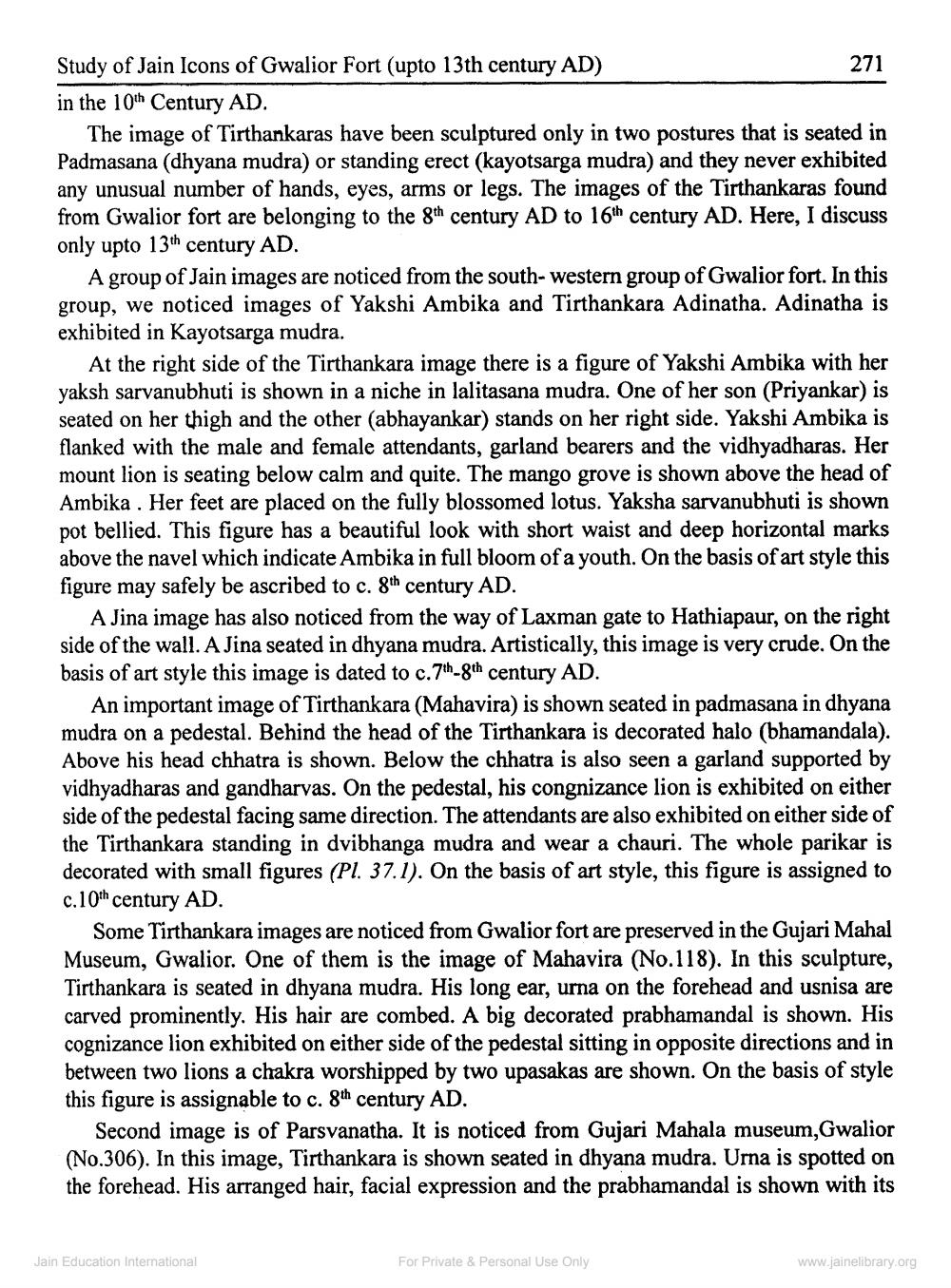________________
Study of Jain Icons of Gwalior Fort (upto 13th century AD)
in the 10th Century AD.
The image of Tirthankaras have been sculptured only in two postures that is seated in Padmasana (dhyana mudra) or standing erect (kayotsarga mudra) and they never exhibited any unusual number of hands, eyes, arms or legs. The images of the Tirthankaras found from Gwalior fort are belonging to the 8th century AD to 16th century AD. Here, I discuss only upto 13th century AD.
271
A group of Jain images are noticed from the south-western group of Gwalior fort. In this group, we noticed images of Yakshi Ambika and Tirthankara Adinatha. Adinatha is exhibited in Kayotsarga mudra.
At the right side of the Tirthankara image there is a figure of Yakshi Ambika with her yaksh sarvanubhuti is shown in a niche in lalitasana mudra. One of her son (Priyankar) is seated on her thigh and the other (abhayankar) stands on her right side. Yakshi Ambika is flanked with the male and female attendants, garland bearers and the vidhyadharas. Her mount lion is seating below calm and quite. The mango grove is shown above the head of Ambika. Her feet are placed on the fully blossomed lotus. Yaksha sarvanubhuti is shown pot bellied. This figure has a beautiful look with short waist and deep horizontal marks above the navel which indicate Ambika in full bloom of a youth. On the basis of art style this figure may safely be ascribed to c. 8th century AD.
A Jina image has also noticed from the way of Laxman gate to Hathiapaur, on the right side of the wall. A Jina seated in dhyana mudra. Artistically, this image is very crude. On the basis of art style this image is dated to c.7th-8th century AD.
An important image of Tirthankara (Mahavira) is shown seated in padmasana in dhyana mudra on a pedestal. Behind the head of the Tirthankara is decorated halo (bhamandala). Above his head chhatra is shown. Below the chhatra is also seen a garland supported by vidhyadharas and gandharvas. On the pedestal, his congnizance lion is exhibited on either side of the pedestal facing same direction. The attendants are also exhibited on either side of the Tirthankara standing in dvibhanga mudra and wear a chauri. The whole parikar is decorated with small figures (Pl. 37.1). On the basis of art style, this figure is assigned to c.10th century AD.
Some Tirthankara images are noticed from Gwalior fort are preserved in the Gujari Mahal Museum, Gwalior. One of them is the image of Mahavira (No.118). In this sculpture, Tirthankara is seated in dhyana mudra. His long ear, urna on the forehead and usnisa are carved prominently. His hair are combed. A big decorated prabhamandal is shown. His cognizance lion exhibited on either side of the pedestal sitting in opposite directions and in between two lions a chakra worshipped by two upasakas are shown. On the basis of style this figure is assignable to c. 8th century AD.
Second image is of Parsvanatha. It is noticed from Gujari Mahala museum, Gwalior (No.306). In this image, Tirthankara is shown seated in dhyana mudra. Urna is spotted on the forehead. His arranged hair, facial expression and the prabhamandal is shown with its
Jain Education International
For Private & Personal Use Only
www.jainelibrary.org




